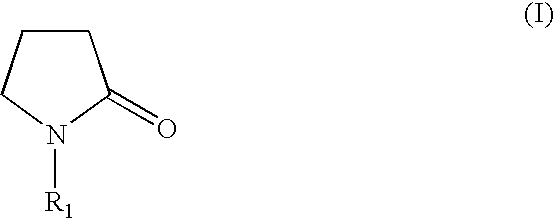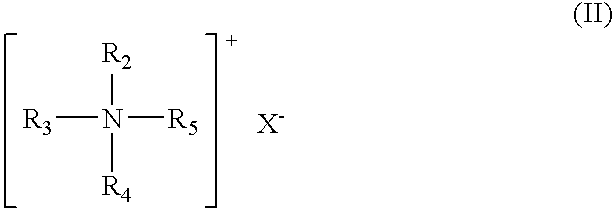Over-coating agent for forming fine patterns and a method of forming fine patterns using such agent
- Summary
- Abstract
- Description
- Claims
- Application Information
AI Technical Summary
Benefits of technology
Problems solved by technology
Method used
Image
Examples
example 1
[0074] A substrate was whirl coated with a positive-acting photoresist TDUR-P036PM (product of Tokyo Ohka Kogyo Co., Ltd.) and baked at 80.degree. C. for 90 seconds to form a photoresist layer in a thickness of 0.48 .mu.m.
[0075] The photoresist layer was exposed with a KrF excimer laser exposure unit (FPA-3000 EX3 of Canon Inc.), subjected to heat treatment at 120.degree. C. for 90 seconds and developed with an aqueous solution of 2.38 mass % TMAH (tetramethylammonium hydroxide) to form photoresist patterns which defined hole patterns with an each diameter of 180 nm (i.e., the spacing between the photoresist patterns, or the initial hole dimension, was 180 nm).
[0076] Over-coating agents formulated as shown in Table 1 were applied onto the substrate including hole patterns and subjected to heat treatment at 116.degree. C. for 60 seconds. Subsequently, the over-coating agents were removed using pure water at 23.degree. C. and the diameters of the hole patterns were measured. In additi...
PUM
| Property | Measurement | Unit |
|---|---|---|
| Percent by mass | aaaaa | aaaaa |
| Percent by mass | aaaaa | aaaaa |
| Percent by mass | aaaaa | aaaaa |
Abstract
Description
Claims
Application Information
 Login to View More
Login to View More - R&D
- Intellectual Property
- Life Sciences
- Materials
- Tech Scout
- Unparalleled Data Quality
- Higher Quality Content
- 60% Fewer Hallucinations
Browse by: Latest US Patents, China's latest patents, Technical Efficacy Thesaurus, Application Domain, Technology Topic, Popular Technical Reports.
© 2025 PatSnap. All rights reserved.Legal|Privacy policy|Modern Slavery Act Transparency Statement|Sitemap|About US| Contact US: help@patsnap.com



